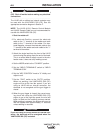
A-4
INSTALLATION
VANTAGE
®
500 (CE)
A-4
HIGH ALTITUDE OPERATION
At higher altitudes, output derating may be necessary. For
maximum rating, derate the machine 1.0% for every 2000 ft.
(610m) up to 6000 ft. (1828m) and 2.0% for every 2000 ft.
(610m) over 6000 ft. (1828m). Due to new EPA and other
local emissions regulations, modifications to the engine for
high altitude are restricted within the United States. If
required contact an authorized Perkins engine field service
shop to determine if any adjustments can be made for oper-
ation in higher elevations.
HIGH TEMPERATURE OPERATION
At temperatures above 104°F(40°C), Welder output derating
is necessary. For maximum output ratings, derate the
welder output 2 volts for every 18°F(10°C) above
104°F(40°C).
Cold weather starting:
With a fully charged battery and the proper oil, the
engine should start satisfactorily down to -15°F(-
26C°). If the engine must be frequently started at or
below 0°F (-18°C), it may be desirable to install cold-
starting aides. The use of No. 1D diesel fuel is recom-
mended in place of No. 2D at temperatures below
23°F (-5°C). Allow the engine to warm up before
applying a load or switching to high idle.
Note: Extreme cold weather starting may require
longer glow plug operation.
Under no conditions should ether or other starting
fluids be used with this engine!
------------------------------------------------------------------------
TOWING
Use a recommended trailer for use with this equipment for road,
in-plant and yard towing by a vehicle(1). If the user adapts a
non-Lincoln trailer, he must assume responsibility that the
method of attachment and usage does not result in a safety
hazard or damage the welding equipment. Some of the factors
to be considered are as follows:
1. Design capacity of trailer vs. weight of Lincoln equipment and
likely additional attachments.
2. Proper support of, and attachment to, the base of the welding
equipment so there will be no undue stress to the framework.
3. Proper placement of the equipment on the trailer to insure
stability side to side and front to back when being moved and
when standing by itself while being operated or serviced.
4. Typical conditions of use, i.e., travel speed; roughness of sur-
face on which the trailer will be operated; environmental con-
ditions; like maintenance.
5. Conformance with federal, state and local laws.
(1)
(1) Consult applicable federal, state and local laws regarding specific requirements for use on public
highways.
WARNING
• Lift only with equipment of ade-
quate lifting capacity.
• Be sure machine is stable when lift-
ing.
• Do not lift this machine using lift
bail if it is equipped with a heavy
accessory such as trailer or gas
cylinder.
FALLING • Do not lift machine if lift bail is
EQUIPMENT can damaged.
cause injury. • Do not operate machine while
suspended from lift bail.
------------------------------------------------------------------------
VEHICLE MOUNTING
Improperly mounted concentrated loads may
cause unstable vehicle handling and tires or other
components to fail.
• Only transport this Equipment on serviceable
vehicles which are rated and designed for such
loads.
• Distribute, balance and secure loads so vehicle
is stable under conditions of use.
• Do not exceed maximum rated loads for compo-
nents such as suspension, axles and tires.
• Mount equipment base to metal bed or frame of
vehicle.
• Follow vehicle manufacturer’s instructions.
------------------------------------------------------------------------
WARNING
PRE-OPERATION ENGINE SERVICE
READ the engine operating and maintenance instruc-
tions supplied with this machine.
• Stop engine and allow to cool before fueling
• Do not smoke when fueling.
• Fill fuel tank at a moderate rate and do not over-
fill.
• Wipe up spilled fuel and allow fumes to clear
before starting engine.
• Keep sparks and flame away from tank.
------------------------------------------------------------------------
WARNING
WARNING


















